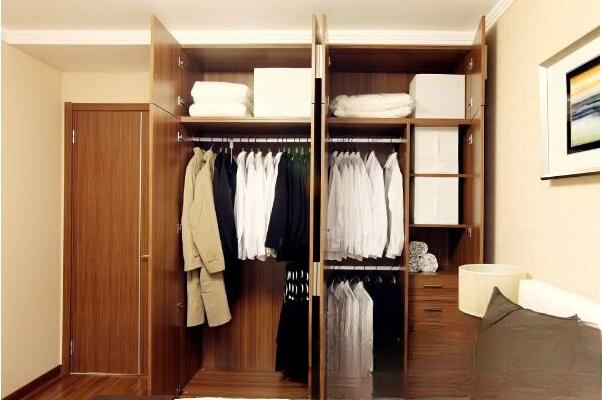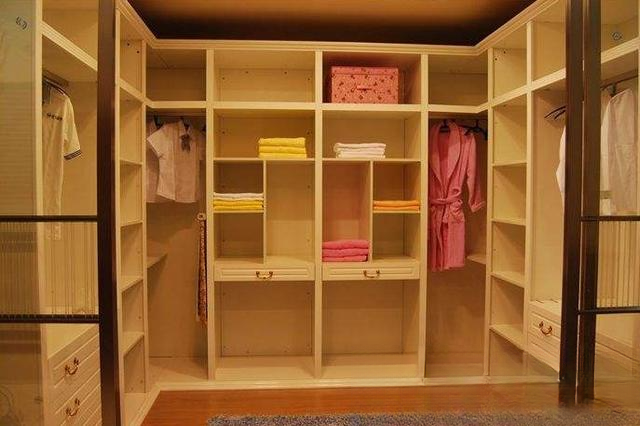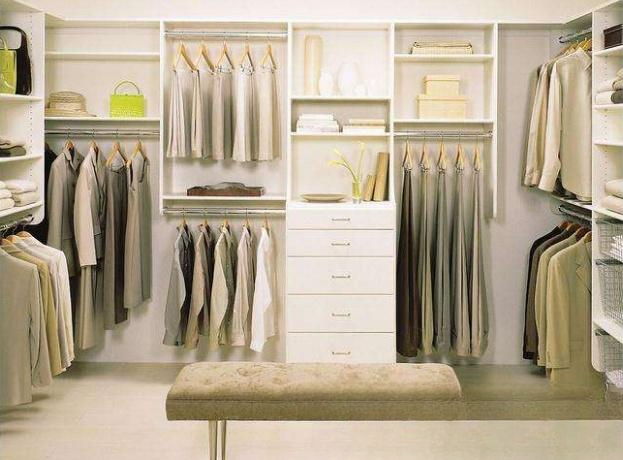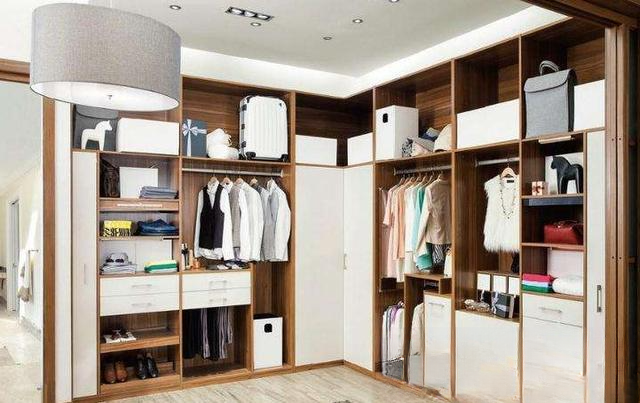Wardrobe design elements and precautions
A well-designed wardrobe can bring a lot of convenience for subsequent use, so what kind of wardrobe can be considered well-designed? A good wardrobe has several elements of wardrobe design. Let’s take a look at the elements and precautions of wardrobe design.

Wardrobe Design Elements
1. Design the wardrobe space reasonably according to the family's population composition
① Elderly people stack more clothes and hang fewer accessories, and most of the clothes may not be worn for a long time. Therefore, when designing, you can consider more independent shelves and drawers to store less used clothes separately. In addition, considering the inconvenience of the elderly, drawers should not be designed at the bottom or low position, but should be about 900mm above the ground, so that the elderly can easily take clothes;
②. The couple’s clothing is diverse, including professional formal wear, casual wear, sportswear, and so on. Generally, the left and right sides are set up as storage spaces for the couple respectively, if the room is large enough. The clothes rack inside the cabinet is divided into two layers, long and short, to store windbreakers, dresses, or tops respectively. Shirts, tops, etc. can be hung in the short layer clothes rack or placed in independent small drawers or shelves, but they cannot be stacked too much, which will cause wrinkles in the clothes. Underwear, ties, and socks can be stored in dedicated fashion drawers, luxury tie clips, and trouser racks, which is not only conducive to clothing maintenance, but also more intuitive and convenient to take out; sweaters and other seasonal clothing can be placed in the top cabinet;
③. Children's clothing. On the one hand, considering the placement of children's toys, it is best to design more drawers, shelves or grid racks when designing the wardrobe. On the other hand, considering that children's clothes will be changed frequently as they grow older, it is necessary to design some places for hanging accessories such as clothes hangers. Moreover, the color of the wardrobe in the children's room is also very particular, and should be mainly warm colors.

2. Reasonable zoning
①. Although every family has a lot of clothes of all ages, large and small, if the space is designed reasonably, it is very convenient to find clothes and save time. You will not have to search through the closet to find a piece of clothing, or a favorite piece of clothing will lie in a corner for a long time.
② In areas where the seasonal rotation is not very obvious, there are not many clothes to be changed each season. It is recommended to divide the wardrobe according to the frequency of clothing replacement. Put some clothes or bedding that are not often changed this season on the top of the wardrobe, and put some clothes that are frequently changed in the lower part, mostly hanging items. In this way, after drying and ironing the clothes, you can hang them directly in an easy-to-reach place, which is very convenient when you need them next time.
3. Standard design
①. Generally speaking, the size of each storage space in the wardrobe is particular. The height of the space for hanging short clothes or tops should not be less than 800mm; the height of the space for hanging long coats should not be less than 1400mm; the height of the drawer should not be less than 150mm~200mm; as for the cabinet for stacking clothes, the width of the cabinet should be between 330mm~400mm and the height should not be less than 350mm based on the width of the clothes after folding; the top of the entire wardrobe is designed as a top cabinet to place quilts and other infrequently used items, and the height should not be less than 400mm.
②. Due to the different structures of each apartment, there may be pillars and beams on the wall where the cabinet is installed. When designing, you should try to make use of the limited space, maximize the storage space of the cabinet, and leave no sanitary dead corners.
③. In addition, according to the rational design standards, the cabinet height is usually 2400mm or 2300mm, while the height of a standard commercial house is 2.8m, so the wardrobe will be divided into two layers. The upper layer is used to place quilts and other infrequently used items, which is the top cabinet, and the lower layer is the space for frequently used clothing.
4. Pay attention to details
①, Accessories: The design of accessories should first consider the available space in the wardrobe, to avoid the wardrobe space is not spacious, but also design too many accessories, on the one hand will lead to serious waste of space inside the wardrobe, can not achieve the storage effect, on the other hand may cause some accessories (such as connectors, screws) can not be used normally;
②. Color: The choice of wardrobe exterior color must be in harmony with the overall decoration style of the home. If the home is dominated by warm colors, the wardrobe color cannot be chosen with cold colors. The wardrobe should become a beautiful landscape in the home. It is recommended to choose a color with a strong natural atmosphere to match the style of the home.

5. Standard design of wardrobe
1. The side panels and shelf panels of the wardrobe and other places that need to bear weight must use 18mm thick melamine pressed medium density fiberboard. The cabinet board must have a national authoritative test report and meet the national mandatory standard GB18584-2001, with formaldehyde emission ≤1.5mg/L and moisture content between 5-11; the back panel does not need to bear weight, so it can be made of 5mm thickness, which can save costs. If conditions permit, the thickness of the door panel and back panel should be 9mm. However, if it is a wall cabinet, the back panel needs to be 18mm thick, with a density standard of 0.6-0.9g/cm3 to enhance the firmness of the wall cabinet;
2. Although the overall wardrobe is a tailor-made product, it can be divided into standard and non-standard. Standard parts are calculated and produced by the manufacturer according to the specifications of the board, which can maximize the utilization of the board. The edge sealing is generally uniform and consistent, and no black lines or sawtooth marks can be seen; non-standard parts will waste a lot of board, so in terms of price, the non-standard price will be a little more expensive;
3. Metal frame of closet door. There are two types of door frames: carbon steel and aluminum. Carbon steel is easy to rust, and aluminum is currently the mainstream. Aluminum includes aluminum-magnesium alloy, aluminum-titanium alloy, etc. Titanium metal has high strength, low specific gravity, and high price. In fact, even aluminum-titanium alloy has the problem of high and low titanium content. Generally speaking, aluminum-titanium alloy makes a crisp sound and has a stronger metallic feel when tapped with fingers. The minimum metal wall thickness requirement is 1.1mm.
4. The wardrobe door panels are made of glass, plates and other materials. The thickness of the glass is 5mm, and the textures include frosted glass, clear glass, cloth-patterned glass and embossed glass to choose from.
5. The materials of sliding door tracks are: aluminum alloy, galvanized steel. The styles are: insert type ceiling, side type ceiling, single track, double track. The door track should be equipped with anti-collision and dustproof devices and positioning systems. Prevent heavy objects and sharp objects from hitting the track, and keep the track straight and smooth.
6. Top and bottom wheels. Ordinary door wheels are electroplated and easy to rust. Wheels are made of ordinary engineering plastics and are easy to wear. High-end door wheels are made of stainless steel shells, high-precision bearings, smooth, no swing difference, and pulleys are equipped with special anti-jump devices. The wheels are made of carbon fiberglass and can be pushed and pulled more than 100,000 times under a load of 180 kg. Some door wheels are made of ordinary plastic (maybe engineering plastics or nylon), and oil is applied to the door wheels to reduce the sound and cover up the defects, but in the future, a lot of dust will stick to them, leaving troubles.

Wardrobe design considerations
Pay attention to transparency
Because of the limited area of small apartments, the distance between the wardrobe and the entrance door is narrow, so it is best to pay attention to the transparency of the wardrobe design. Hollow partitions and cabinets are commonly used elements in small apartment wardrobes. Chinese and Western transparent lattices, columns, cabinet column combination, half-height cabinets, half-cabinet hangings, screens, and silk gauze curtains are all good transparent partitions without a sense of oppression.
The proportions should be coordinated
The width of the wardrobe should be the width of the door plus the width of the door pier, which is generally 90-110cm. If the width of the wardrobe is too small, it will affect the effect of the wardrobe and the appearance will not be high. The width of the wardrobe should be around 90cm to be more comfortable.
Keep the style consistent
The wardrobe reflects the taste of the whole house at the entrance, so the wardrobe must be consistent and coordinated with the overall home decoration style when designing. The partial design of the wardrobe can be made more exquisite and more thoughtful. For example, for a Chinese-style wardrobe, you can choose a slightly more sophisticated wardrobe cabinet.
The material should be warm
Wardrobe design generally recommends using warm materials, such as wood, gauze, and fabric, and less use of cold reflective materials such as glass, mirror, and stainless steel. More sophisticated ones can use semi-transparent wooden lattices, wooden columns, column cabinets, half-height cabinets, wooden screens, silk gauze curtains, and other materials, combined with local glass, metal curtains, and other materials.
The above are some wardrobe design elements and precautions compiled by the editor. When choosing or customizing a wardrobe, you should consider the above content, so that you will feel much more comfortable when using the wardrobe in the future. The above is the content introduced today, I hope it can help you.